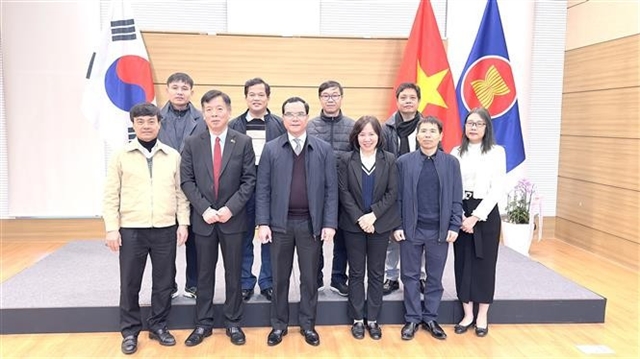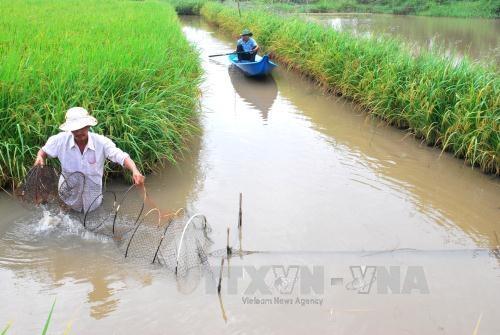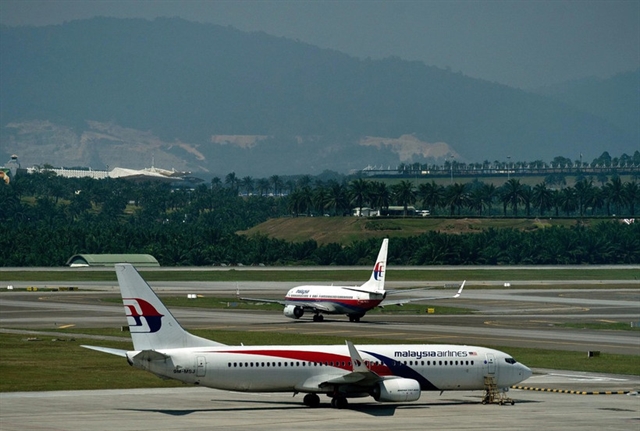 Society
Society

Rotating rice and shrimp farming on the same fields in the Mekong Delta has proven so economically effective and environmentally friendly that experts have urged the creation of zoning areas for the cutlivation model.
 |
| Farmers check shrimp in a rice-shrimp field in the Cửu Long (Mekong) Delta province of Bạc Liêu. — VNA/VNS Photo Huỳnh Sử |
HCM CITY — Rotating rice and shrimp farming on the same fields in the Mekong Delta has proven so economically effective and environmentally friendly that experts have urged the creation of zoning areas for the cutlivation model.
Under the model, which was created by farmers in the Delta’s coastal areas, farmers grow rice in the rainy season and allow saline water to enter fields to farm shrimp in the dry season.
The model has a yield of 300-500kg of shrimp and 4-5 tonnes of paddy per hectare each year, providing profits of VNĐ35-50 million per ha (US$1,500–2,300) a year, according to the Directorate of Fisheries.
Rice-shrimp fields also have 15-30 per cent higher profits than when only rice or shrimp is cultivated in areas where saline water intrusion occurs in the dry season.
Shrimp bred in rice-shrimp fields also have less disease outbreaks as rice cultivation helps improve the soil. In addition, shrimp are farmed at a low density of three to five shrimp per sq.metre and are not given animal feed.
Speaking at a recent forum held in Bạc Liêu Province, Trần Văn Khởi, acting director of the National Agriculture Extension Centre, said the cultivation model needed less pesticides and antibiotics, thus ensuring cleaner produce and environmental protection.
However, irrigation systems as well as water supply and drainage canals are not well developed and other obstacles include a lack of quality rice seeds, shrimp fries and standard farming processes to improve yields, he said.
Zoning for rice-shrimp farming would help reduce these problems, he said.
Since the cultivation model uses rice fields to convert to other crops, support policies could be created for farmers, he said.
Nguyễn Công Thành of the Minh Hải Fishery Research Sub-institute said proper attention should be paid to shrimp fries and rice seeds used in the model.
“Shrimp fries should be quarantined before breeding and rice seeds should be suited to the conditions of localities. And the farming schedules of rice and shrimp must be strictly followed. If this is done, the model could be sustainable,” he said.
Under the model, farmers breed black-tiger shrimp, white-legged shrimp or blue-legged prawn and cultivate several kinds of saline-resistant rice varieties that can grow in water with salt content of up to 0.5 per cent. All of these rice varieties have a high yield.
Nguyễn Văn Hoà, deputy head of the Ministry of Agriculture and Rural Development’s Plant Cultivation Development, said: “The Plant Cultivation Development and the National Seed Centre are researching new rice varieties resistant to saline water and suited to the rice-shrimp farming model.”
The Cửu Long Delta Rice Research Institute has created 11 new rice varieties that can grow in saline water with a salt content of 0.2-0.6 per cent. The varieties have a yield between 5-9 tonnes per ha.
This year, the delta’s area under the shrimp-rice farming model has increased to about 153,000ha, up 2.5 times against 2000, according to the Directorate of Fisheries.
The coastal provinces of Kiên Giang, Cà Mau and Bạc Liêu have the largest areas of rice-shrimp farming in the Delta.
Expansion potential
Hoà said the area under shrimp-rice farming in the Delta was expected to increase to 200,000ha by 2020.
“Areas that have potential for rice-shrimp farming should be zoned. Programmes and investment projects for rice-shrimp farming and environmental evaluation should be built,” he said.
Phan Thanh Lâm of the Institute of Aquaculture No 2 said rice-shrimp farming in the delta was an open farming model as most farming conditions depend on the region’s weather and climate conditions.
“To reduce risk of saltwater intrusion and be effective, proper attention should be paid to implementation, cultivation schedules, improvement of fields, water pumping systems and community-based management models,” he said.
The community-based management model of rice-shrimp farming, also known as a large-scale rice-shrimp field, is implemented in several delta provinces.
In 2014, the National Agriculture Extension Centre chose 25 households in Kiên Giang Province’s An Biên District whose adjoining fields with a total area of 42ha rotated shrimp and rice cultivation on the same schedule and process, managed by the community.
Participating households were paid 60 per cent of shrimp fry costs and 30 per cent of input materials and shrimp food costs.
The profits from shrimp and rice cultivation of the households totalled VNĐ56.8 million ($2,500) per ha, according to the province’s Agriculture and Fishery Extension Centre.
Last year, 23 households with 40ha of adjoining fields in Kiên Giang’s An Minh District begun participating in this model and earned profits of about VNĐ30 million per ha each year.
The National Agriculture Extension Centre has also implemented this model in Cà Mau, Bạc Liêu and Sóc Trăng provinces, attracting the participation of a total of 190 households with a combined area of 190ha. —VNS




